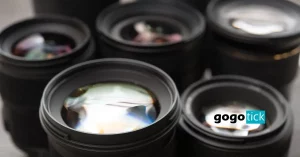One of the biggest concerns photographers have with using the zoom feature on a camera is whether it can maintain picture quality while getting in close to the image at hand. After all, there’s not much point in zooming in on a photo only to end up with a blurry mess when you take it.
So does zooming on a camera reduce picture quality? The answer is yes, digital zooming does reduce picture quality because it operates by cropping the image. This stretches a smaller number of pixels and results in lower resolution than with an optical zoom feature, which maintains a higher number of pixels and a higher overall resolution.
Zooming in on an image without knowing how the zoom feature actually works can result in bad photos but zooming can be achieved without lowering picture quality. Read on to find out more about how to take close-ups without losing quality in your final photograph.
What is Zoom in Photography?
In the age of digital photography, zoom on a camera can mean different things. A zoom lenses on a professional camera is a much different tool than the zoom function on digital photo editing software. While both functions serve to enlarge and crop the image at hand, a camera with a manual zoom function will be able to take much more detailed close-ups than a digital zoom feature.
Not only do zoom features allow you to take close-up images of your subject, they also allow you to take images at varying distances from the subject, opening the photographer up to a much wider range of shooting compositions to choose from.
Zoom lenses are capable of operating in both full light and low light, allowing the photographer to take more detailed photographs even in less-than-optimal shooting conditions. Digital zoom features allow a photographer to focus the center of their photograph on a closer frame-up of the subject, but at the expense of resolution.
While high-quality optical zoom lenses can be somewhat costly, they are a necessary investment for those who like to take macrophotography or people who are wildlife photographers, depending on their distance from their subject to be able to get the shot.
Digital Zoom on Digital Cameras Degrades Quality
Digital zoom is a common feature in both digital cameras and post-editing photography software, but digital zoom does not maintain photographic quality in the same way an optical zoom feature does. Because digital zoom operates at a lower number of pixels than the original image, some of the sharpness of the image is necessarily lost.
Optical zoom lenses get around this problem by actually moving a telescopic lens closer or further away from the subject of the photograph, which results in no loss of clarity or pixels during the generation of the image. This is why manual zooming cameras are preferred by professional photographers over the cameras present in cellphones.
Many people consider phone cameras to be good with regards to zooming features, but those photographers who are into fine art photography or professional photography will be able to recognize the difference in clarity between a close-up photograph taken on a standard cellphone camera and a close-up photograph taken on a full photographer’s camera.
Digital Cameras with Optical Focus Overcome Zooming Quality Issues
Ultimately, digital zoom features are the equivalent of a bad cropping job. If you really want to take high-quality close-up photographs (digital or otherwise) you need to invest in some optical zoom lenses. Digital zoom features are getting better all the time, but they still can’t hold a candle to manual zoom features in a camera when it comes to telescopic clarity.
Cell Phone Telescopes Can Increase Zooming Quality on a Camera Phone
For those photographers who want to improve the quality of their close-up photos but don’t want to invest in a high-quality camera due to the expenses involved, another option to look into is cell phone telescopes. These accessories provide manual zoom capability and act in the same way as a manual optical lens on a more expensive camera.
All Camera Lenses Vary in Sharpness at Different Focal Lengths
Even though cameras with an optical zoom capability will be able to take clearer close-up photographs than a digital camera with a digital zoom feature only, any camera lens varies in sharpness at different focal lengths, which means that at a certain distance almost all photographic lenses will introduce blur around the edges of the image.
There are two ways to get around this issue—investing in a few different lenses that you can rotate between when shooting subjects at different distances, and intimately learning how your camera operates—knowing where those blurred focal lengths are on your favorite camera lens can be the difference between catching the shot and missing it.
Optical Zoom vs. Digital Zoom Capabilities
While both optical zoom lenses and digital zoom features offer zoom capability, the quality of the resulting image can sometimes be quite different. Digital zoom features allow the photographer to re-center the image on a portion of the original image and zoom in, but this decreases the number of pixels in the shot and introduces blur.
Optical zoom lenses operate like a telescope attached to the camera, allowing it to make the image in the camera’s view larger without sacrificing pixels. This results in a final image that has a higher resolution and sharper detail.
How to Reduce Poor Picture Quality in Zoomed Images
One way to help prevent poor picture quality when you’re using digital zoom on an image is to check your camera’s ISO settings and make sure they aren’t too high—if so, the resulting images will be grainy and have a lot of noise, reducing clarity when the picture is zoomed in.
The ISO is the camera setting that adds brightness or darkness to the photo. If the brightness on your camera is turned up too high, this decreases the overall quality of the resulting image. From a distance, this might not make much of a difference, but it will make it much more difficult to get a quality close-up of the same image.
The clarity of a digital enlargement can also be enhanced in post-processing software such as Photoshop or GIMP. In this software, anti-aliasing can be adjusted along with color and resolution to produce a sharper enlargement.
Zooming and Picture Brightness
One of the downsides to zooming in on an image with an optical lens is that this results in reduced brightness of the final image unless the camera compensates for the brightness reduction. Cameras that are capable of zooming without loss of brightness are known as constant aperture zooms. While these cameras are expensive, they can give a brighter final image without the need for post-process editing.
For those cameras without constant aperture, dimming of the photograph must be manually corrected or corrected after the image is shot. Even cameras that do have a constant aperture zoom function still deal with loss of light past 80% zoom enhancement.
Combine Digital and Optical Zooming for Highest Close-up Quality
While optical zoom lenses are preferred over digital zoom capabilities for better quality close-ups, the best zoomed photographs are taken with a combination of both techniques. Thanks to the advancement of photographic technology, digital cameras are increasingly able to compete with professional cameras. Digital zooming alone, unfortunately, has a reputation for reducing picture quality.
Optical zoom lenses aren’t a cheap investment for a photographer, but these lenses allow you to take photographs you might not ever achieve otherwise.



































